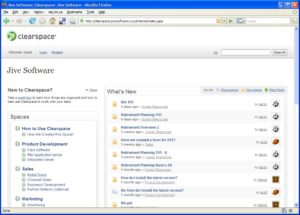Today started out with another panel — seems to be the more common format for breakout sessions here rather than individual speaker. I was a few minutes late and came in on someone from a vendor that I hadn’t heard of talking about his product, then Joe Schwartz of WebEx took over to talk about how they’re doing Enterprise 2.0 internally using their own technology. Because they have large operations in China, they need to be able to collaborate across a wide geography, for which their using their core web conferencing/desktop sharing product, but also leveraging blogs, podcasts, RSS feeds and other mechanisms in their outward-facing marketing. He also mentioned how they use social networking in the sales organization using tools like LinkedIn and Visible Path.
Because of the nature of their business and the fact that so much of their business is sold remotely, their sales force is really focussed on enhancing their virtual presence and touch-points. This is the first time that I’ve really heard about how social networking can make a difference for the sales side of the house; most case studies focus on inward-facing projects and people, or on the customer community in a post-sales scenario. They use a tool called SalesGenius, integrated with their CRM, to help with this; in fact, since it’s a hosted service, the sales department started it on a trial basis without IT even knowing about it. Even now, there’s no IT involvement, and a relatively low monthly cost gave them almost an immediate ROI.
Next up was Jeff Herrmann of Manning & Napier, an investment management firm, about how they implemented blogs and wikis internally using the SocialText platform. They already had a fairly collaborative culture, especially in their analytical team, but they had a problem with just capturing and retrieving knowledge (in part because of the relatively high turnover in personnel that is endemic in the industry), with communicating information between departments, and with facilitating virtual and asynchronous discussions. Funnily enough, he found it easy to get buy-in at the bottom (people who probably weren’t being heard, and saw this as an opportunity) and the top (executives who had the vision to understand how social networking could make their business work better), but said that he’s still working on the middle. And surprisingly, the most prolific blogger in the firm is the 71-year-old chairman.
We then heard from Maria Barnum of Bank of America on how they’re using RSS to distribute information out to their branch network: this is one-way notifications of everything from weather alerts to fraud notices, and used to be done by faxing or remote printing. They’re using a blog tool to publish information, since RSS is built right in, and categories allow for easy filtering of the feeds by region and role. They use a small RSS reader that sits in the system tray that alerts the user when a new item is available; essentially, they’ve created an alternative to email for distributing this type of information, which is a pretty interesting application for RSS. They use ActiveDirectory to determine that information and push specific feeds to specific people; I’d love to hear more about how they do that, since that’s an essential part of using RSS technologies in some enterprise applications. Someone asked what blog and reader technology that they are using, and Barnum said that she was not allowed to do product endorsements; I don’t think that the conference organizers intended that she not even mention the product name (after all, the previous speaker mentioned SocialText explicitly).
I consider RSS to be the next big thing in information distribution, and I’m actively paring down my email newsletter subscriptions (which I almost never read) in favour of RSS subscriptions, which assures that my email address isn’t getting spammed. I also think that RSS needs to be used much more heavily to deliver alerts and other information from enterprise applications: it provides a standards-based way to send out information that can be consumed on a variety of platforms.

